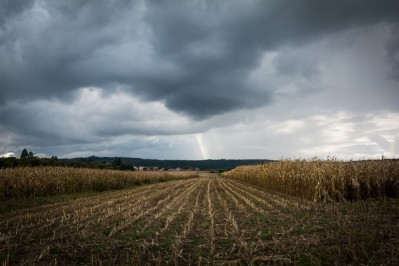Uncertainty in corn, soy production overshadows WASDE data

The US Department of Agriculture released details about anticipated global crop production, use and trade in a World Agricultural Supply and Demand Estimates report Thursday (July 11).
However, there remain several questions about the total acres of corn planted in the US along with corn and soybean yield predictions, said Todd Hubbs, clinical associate professor of agricultural commodity markets with the University of Illinois.
The market did not take the report information regarding anticipated corn production as seriously as it has with previous reports because of the remaining uncertainty about feed crop planting, he said. The most recent report did not alter the number of acres planted in corn from the 91.7m acres that had been previously reported and increased predicted production.
“Corn prices went up – July is up $0.13,” he said of the response to the report. “It should have been a bearish report for corn, but nobody believes the acreage number.”
Instead, the anticipation is that a new survey to be done of corn and soybean growers in July could provide more accurate data about the total number of acres planted, depending on how the survey is conducted, he said. That information is set to be shared in August.
“It’s a slow-moving train wreck,” said Hubbs of the situation. “It’s like the market at some point will wake up to this idea that we’ve got a supply shock here in corn, in particular, but probably in beans as well.”
Feed users could see challenges from corn higher prices later in the season if the expected drop in production is confirmed, he said. Corn prices have already increased since mid-May, even with recent price weakness.
The export market for corn has already started to weaken and there could be a “domestic fight” for corn to be used for feed or for ethanol production, he said.
“At this point, the market has priced in what the USDA has put out there, plus a little bit of fade on the acreage [but] I don’t think the full yield story or the full acreage story is in the corn market yet,” he said. “The uncertainty is so massive … you can make a case that corn will be $4 this fall, or you can make a case that corn will be $6 this fall – it’s that big of a swing.”
Corn statistics
Overall, the US corn crop is forecast to have an increase in production, beginnings stocks, feed use and ending stocks, the USDA said. However, food, seed and industrial use is expected to fall.
Beginning stocks for the feed crop were increased by 145m bushels based on the use forecast for 2018/19, and current sales and shipments led to exports being lowered, the department said.
Production for 2019/20 has been increased by 195m bushels based on the reported growth in planted and harvested acres in the June 29 Acreage report. However, delayed planting is prompting the National Agricultural Statistics Service (NASS) to collected updated information about acres planted in corn and, if necessary, updated acreage estimates are set to be released in August.
The average corn yield has not been altered, the department said. But, delayed maturity in the corn crop places the important pollination period in late July and early August.
Feed and residual use is expected to increase based on the larger crop, the department said. However, the fall in ethanol production is expected to reduce corn use by 20m bushels and overall stocks were increased by 335m bushels.
International corn production anticipates a larger crop and increased trade, the USDA said. Production is expected to be higher in Ukraine and Argentina.
In 2019/20 Ukraine is anticipated to see increased exports, while Brazil and Argentina are expected to see higher exports in 2018/19, the department said.
Soybean considerations
Looking to 2019/20, soybeans are anticipated to have reduced beginning and ending stocks, production and exports, the USDA said. Increased use in 2018/19 has offset the drop in soybean crush and seed use.
Total production in 2019/20 is forecast to be 3.84bn bushels, a drop of 305m resulting from a smaller planted and harvested area, the department said. However, this could be updated following the NASS data collection effort.
Soybean yields have been reduced by 1 bushel an acre based on the delayed planting in major producing states, the department said. And, export expectations dropped 75m bushels based on competition from South America.
The season-average soybean price was raised $0.15 per bushels and soybean meal prices increased $5 a short ton, the department said.
Globally, the prediction for oilseeds is that production will drop based on the soybean crop in the US, Canada and Ukraine, the rapeseed crop in the EU, Australia and Canada and the sunflower seed crop in Russia.
International trade is expected to be down for oilseeds as the decline in soybean exports from the US also is expected to offset increased export trade from Brazil, Argentina and Uruguay, the department said. Global oilseed ending stocks for 2019/20 fell 10.7m tons based on the smaller soybean stocks anticipated in the US, Argentina and Brazil.
Wheat details
The anticipated outlook for wheat in the 2019/20 marketing year expects a reduction in supplies, increased domestic use along with larger exports and lower stocks, said the USDA. Increased production is not predicted to offset the smaller carry-in, leading to the reduced supply.
However, wheat production in 2019/20 is expected to increase by 18m bushels, the department said. And, the combined yield for “all wheat” has been raised by 1.3 bushels an acre.
Domestic use also is up slightly based on feed and residual use, and wheat is anticipated to be “more competitively priced with feed grains in 2019/20,” the department said.
Exports are predicted to increase by about 14m bushels from those seen in 2018/19, the USDA said. Supplies from several international exporters were reduced in 2019/20 forecasts, and the US is anticipated to be more competitive globally – especially toward the end of the 2019/20 marketing year.
Ending stocks for 2019/20 were lowered 72m bushels, the department said. The season-average farm price was increased $0.10 a bushel.
Globally, wheat supplies are expected to drop by about 10.5m tons in 2019/20 based on reduced production in Russia, the EU and Ukraine, the USDA said. All three regions saw high temperatures and dry weather during June, which is anticipated to lower yields.
Additionally, production in Australia and Canada was reduced based on the area planted in wheat, the department added.
International exports were reduced 2.3m tons based on the smaller supply, the department said. However, the EU and US are predicted to see an upturn in exports.
Overall, world wheat consumption is predicted to drop by 2.9m tons and global ending stocks were reduced by 7.9m tons, the department said. However, ending stocks remain record large.













